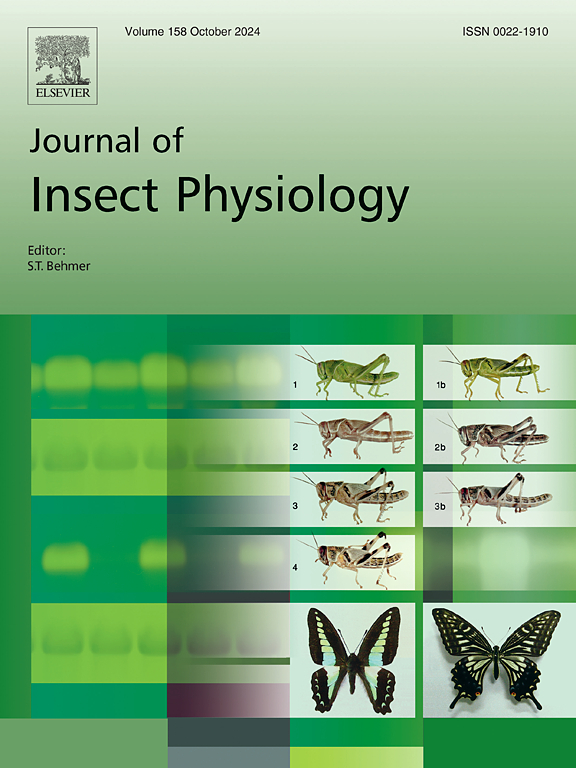通过纳米粒子屏蔽的dsRNA递送,家蚕成功的口服RNA干扰效率。
IF 2.3
2区 农林科学
Q1 ENTOMOLOGY
引用次数: 0
摘要
双链RNA (dsRNA)介导的RNA干扰(RNAi)是一种功能基因研究和害虫防治的工具。然而,与RNAi敏感的鞘翅目相比,鳞翅目的RNAi效率较低。以往在鳞翅目模式昆虫家蚕(Bombyx mori)中的RNAi研究仅通过注射进行。在家蚕体内成功的口服RNAi尚未见报道。本研究旨在开发一种成功的家蚕幼虫口服dsRNA的方法。壳聚糖是一种经济、可生物降解的聚合物。采用自组装法制备了壳聚糖/dsRNA纳米颗粒。这些纳米颗粒被发现在蚕幼虫的中肠液中孵育时是稳定的,而裸dsRNA则完全降解。靶向多种免疫基因的壳聚糖/dsRNA纳米颗粒经家蚕幼虫口服介导了基因转录的显著下调。以BmToll9-2基因为靶点的壳聚糖/dsRNA纳米颗粒可使家蚕幼虫和茧变小,提示免疫基因可作为害虫防治的靶点。优化后的壳聚糖/dsRNA纳米颗粒在3-5天内保持RNAi效应。有效的RNAi是由于纳米粒子屏蔽的dsRNA在幼虫中的持久性。上述研究成果首次在家蚕中进行了口服RNAi的报道,为RNAi在昆虫中的应用以及口服RNAi在害虫防治中的应用奠定了基础。本文章由计算机程序翻译,如有差异,请以英文原文为准。

Successful oral RNA interference efficiency in the silkworm Bombyx mori through nanoparticle-shielded dsRNA delivery
Double-stranded RNA (dsRNA) mediated RNA interference (RNAi) is a tool in functional gene study and pest control. However, RNAi efficiency in Lepidoptera is low compared to the RNAi sensitive Coleoptera. Previous studies on RNAi in the silkworm Bombyx mori, the lepidopteran model insect, were performed by injection only. Successful oral RNAi in the silkworm has never been reported yet. This study aims to develop a successful oral dsRNA delivery method to the silkworm larvae. Chitosan is an economical and biodegradable polymer. Chitosan/dsRNA nanoparticles were prepared by self-assembly. These nanoparticles were found to be stable when incubated in the midgut juice of the silkworm larvae, whereas naked dsRNA underwent complete degradation. Chitosan/dsRNA nanoparticles targeting various immune genes in oral administration to the silkworm larvae mediated significant knockdown of gene transcript. This silencing effect resulted in smaller larvae and cocoons when the silkworms were fed with Chitosan/dsRNA nanoparticles targeting BmToll9-2 gene, indicating that immune genes might be used as targets in pest control. Optimization of the chitosan/dsRNA nanoparticles maintained an RNAi effect from 3-5 days. The efficient RNAi was due to the persistence of nanoparticle-shielded dsRNA in the larvae. The above findings contribute to the first oral RNAi report in the silkworm, which facilitates the application of RNAi in insects and oral RNAi in pest control.
求助全文
通过发布文献求助,成功后即可免费获取论文全文。
去求助
来源期刊

Journal of insect physiology
生物-昆虫学
CiteScore
4.50
自引率
4.50%
发文量
77
审稿时长
57 days
期刊介绍:
All aspects of insect physiology are published in this journal which will also accept papers on the physiology of other arthropods, if the referees consider the work to be of general interest. The coverage includes endocrinology (in relation to moulting, reproduction and metabolism), pheromones, neurobiology (cellular, integrative and developmental), physiological pharmacology, nutrition (food selection, digestion and absorption), homeostasis, excretion, reproduction and behaviour. Papers covering functional genomics and molecular approaches to physiological problems will also be included. Communications on structure and applied entomology can be published if the subject matter has an explicit bearing on the physiology of arthropods. Review articles and novel method papers are also welcomed.
 求助内容:
求助内容: 应助结果提醒方式:
应助结果提醒方式:


